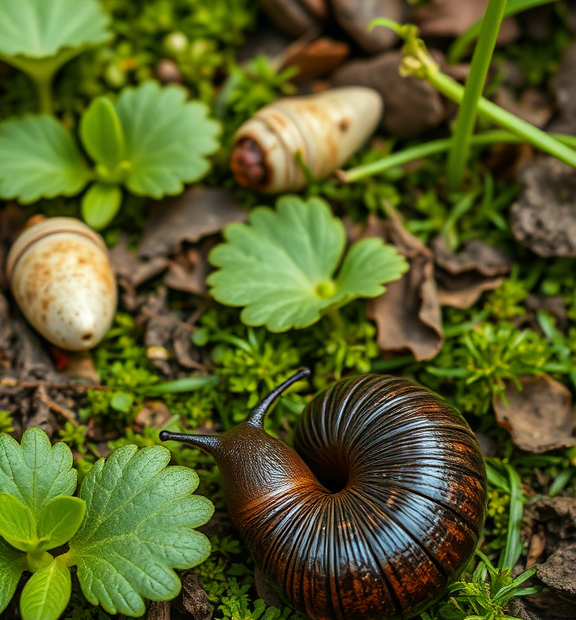Effective Natural Methods on How to Get Rid of Slugs in Your Garden
Slugs can wreak havoc in your garden, munching on plants and leaving behind a trail of destruction. If you’re tired of these slimy intruders and want to learn how to get rid of slugs in your garden using natural methods, you’re in the right place. Several effective techniques can help you keep your garden slug-free without resorting to harmful chemicals.
One of the simplest ways to deter slugs is to create barriers. These barriers can be physical or made from natural materials. Some effective barrier methods include:
- Copper Tape: Place copper tape around the perimeter of your garden beds. The copper reacts with the slug’s slime, giving them a mild electric shock when they attempt to cross it.
- Crushed Eggshells: Sprinkle crushed eggshells on the soil. The sharp edges will deter slugs from crossing into your plants.
- Sand or Diatomaceous Earth: A ring of sand or food-grade diatomaceous earth can create a rough surface that slugs find uncomfortable to crawl over.
Another effective strategy is to remove their hiding spots. Slugs thrive in moist, dark environments. To minimize their habitat:
- Clear Debris: Regularly clear away garden debris, such as fallen leaves and used pots, where slugs can hide.
- Water Wisely: Water your garden in the morning rather than the evening. This allows moisture to evaporate during the day, making your garden less appealing to slugs at night.
When thinking about how to get rid of slugs in your garden, consider implementing beneficial plants that deter these pesky pests. Certain plants have natural properties that repel slugs, including:
- Lavender: The strong scent of lavender is off-putting to slugs.
- Rosemary: This fragrant herb acts as a natural deterrent.
- Thyme: With its robust scent, thyme can help keep slugs at bay.
In addition to repellent plants, you might want to introduce a few natural predators into your garden. Certain animals love to snack on slugs, including:
- Toads: These creatures are natural slug hunters. Creating a toad-friendly environment encourages them to take up residence in your garden.
- Birds: Various birds will feast on slugs. You can attract them by placing bird feeders and providing nesting areas.
- Ground Beetles: These beetles are effective predators of slugs and can be encouraged by keeping your garden organic.
Another innovative approach using beer can yield great results. Create beer traps by sinking containers or shallow bowls into the ground, leaving the rim level with the soil surface. Fill these traps with beer, which attracts slugs. They will crawl in and drown! Remember to check the traps regularly and replace the beer as needed.
If you have daylilies or hostas in your garden, consider using an old trick: a simple mixture of soap and water. Mix a few teaspoons of liquid soap with water in a spray bottle and lightly spray the foliage in the evening. Slugs, being soft-bodied, will absorb the soap and dehydrate, ultimately leading to their demise.
Love what I do? Be a hero and help me keep creating awesome content!
Support My Mission Now!Every donation fuels more great stuff – thank you, legend!
Maintaining the right soil pH can also be beneficial. Slugs prefer acidic soils, so testing your soil and adjusting it to be more alkaline using lime can help. Adding lime may not only make your soil healthier for plants but also discourage slug populations.
Regularly monitor your garden for signs of slug activity. Check at night, as slugs are most active after dark. With these proactive measures and strategies, you can effectively manage and significantly reduce the presence of slugs in your garden. Natural methods are effective and safe, protecting the environment and ensuring a healthy, vibrant garden.
Understanding the Lifecycle of Slugs and Their Impact on Garden Health
Love what I do? Be a hero and help me keep creating awesome content!
Support My Mission Now!Every donation fuels more great stuff – thank you, legend!
Slugs are common garden pests that can create significant challenges for any gardener. Understanding their lifecycle is key to managing their impact effectively and promoting a healthy garden ecosystem. With their delicate shells and slimy bodies, slugs are often underestimated, but they can wreak havoc on your plants if left unchecked.
The lifecycle of slugs begins with mating in the spring and early summer when they emerge from hibernation. After mating, female slugs lay clusters of eggs, usually in damp, secluded spots like under leaves or debris. A single female can lay up to 80 eggs at a time, which are small, round, and translucent. These eggs hatch within two to four weeks, depending on environmental conditions such as temperature and moisture. Once hatched, baby slugs, known as juveniles, begin to grow quickly and usually reach maturity within two to three months.
During their growth, slugs navigate their surroundings by seeking out moist environments which are essential for their survival. They thrive in damp conditions, making gardens rich in organic matter particularly vulnerable. If you notice abundant leaves and a lush garden environment, you might also find an increase in slug populations. This is due to the ideal conditions that support their lifecycle.
Love what I do? Be a hero and help me keep creating awesome content!
Support My Mission Now!Every donation fuels more great stuff – thank you, legend!
Slugs primarily feed on soft, leafy plants, and they can inflict serious damage. They tend to be most active during the night or in overcast weather, making them stealthy diners in your garden. Common plants affected by slugs include:
- Lettuce
- Spinach
- Peas
- Hostas
- Strawberries
As they consume these plants, slugs can cause ragged holes in leaves, stunted growth, and even plant death. This can lead to a decline in garden health, affecting both yield and the aesthetic appeal of your outdoor space. Understanding their diets and feeding patterns is essential for developing effective management strategies.
Love what I do? Be a hero and help me keep creating awesome content!
Support My Mission Now!Every donation fuels more great stuff – thank you, legend!
To combat slugs, gardeners can employ several techniques while being mindful of their environment. Here are some effective methods for controlling slug populations:
- Remove Hiding Spots: Clear away debris, such as old leaves and tall weeds, where slugs may hide during the day. This helps reduce their habitats.
- Use Barriers: Copper tape can deter slugs as they emit a mild electrical charge upon contact. Placing this tape around plant beds can act as a physical barrier.
- Encourage Natural Predators: Introduce slug predators such as birds, frogs, or beneficial insects into your garden. Maintaining a balanced ecosystem can help control slug populations naturally.
- Trap Slugs: Setting up traps using beer or a mixture of equal parts water and yeast can attract and drown slugs. Place the traps in areas where you notice high slug activity.
- Use Organic Slug Baits: Consider using organic slug baits containing iron phosphate, which are safe for pets and wildlife. These baits attract slugs, allowing them to consume the bait and eventually die.
It is also important to regularly inspect your garden for signs of slug activity. Look for slime trails on leaves or the ground, as well as chewed plant foliage. Early intervention can make a significant difference in managing their populations effectively.
Furthermore, gardening practices like crop rotation and maintaining healthy soil can enhance plant resilience against slug damage. Strong, healthy plants are less likely to suffer severe repercussions if they do encounter slugs.
Knowing about the lifecycle of slugs and their impact on garden health is crucial for every gardener. Through effective pest management techniques, you can enjoy a thriving garden while minimizing the threat posed by these slimy intruders. By taking proactive steps, you can keep slugs at bay and ensure your plants flourish throughout the growing season.
Conclusion
To maintain a flourishing garden, it’s essential to combat the challenges posed by slugs. Understanding their lifecycle allows you to identify when they are most active and vulnerable. By employing effective natural methods, you not only protect your plants but also contribute to a healthier ecosystem. High humidity and damp conditions make gardens a suitable habitat for slugs, so reducing moisture can be an effective strategy.
Consider implementing barriers like copper tape or using natural repellents such as crushed eggshells and diatomaceous earth. These methods are eco-friendly and safe for your plants and pets. Remember that a healthy garden often begins with prevention.
Regularly checking your garden for signs of slugs can help you catch infestations before they cause significant damage. Hand-picking slugs in the early evening, when they are most active, can also serve as a quick solution.
Emphasizing natural solutions not only aids in slug control but also cultivates a vibrant garden by promoting biodiversity. By working with nature, instead of against it, you can establish a flourishing environment for your plants while keeping troublesome slugs at bay. Your continued efforts in understanding and managing slug populations will pay off, allowing your garden to thrive and bring you joy season after season.

